A leg of lamb is an impressive main dish for any celebration. This traditional French Easter dish of roast leg of lamb with rosemary and garlic is the perfect dish to wow any guests!
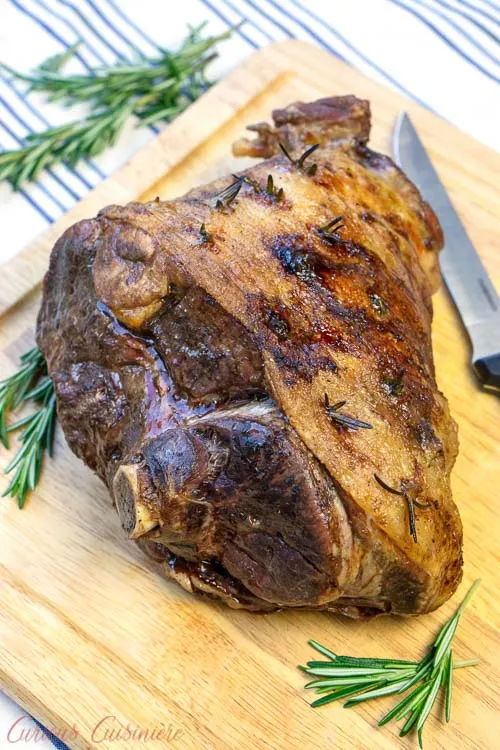
What is le gigot d’agneau?
“Le gigot d’adneau” is French for “leg of lamb”.
Lamb is an incredibly common main dish for Easter celebrations in France, and in much of Europe.
French cooking might be known for being a bit complicated and over the top, but even with a seemingly fancy name, the preparation for this roast leg of lamb is so incredibly simple.
The leg is studded with garlic cloves and fresh rosemary sprigs and roasted at a low temperature to achieve a tender, flavorful result.
Should I cut the fat off a leg of lamb?
A good cut of lamb should have ribbons of fat throughout the meat.
Like beef roasts this inter-muscular fat is called marbling and will keep the meat tender as it cooks. This is fat that you definitely don’t want to get rid of.
Since we’re roasting our leg of lamb low and slow, even having a fat cap on the leg of lamb is not a bad thing, since this fat will render out as the meat cooks, basting the meat and keeping it juicy.
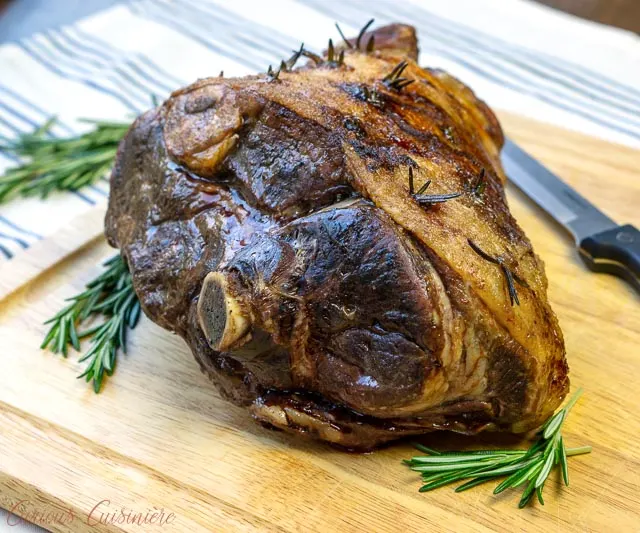
And, since we’re using a raised roasting pan to cook the meat, any excess fat will simply collect in the pan, not in/on your meat.
(This collected fat we’ll use to make gravy, so if you’re looking to go leaner, then skip the gravy.)
How much lamb should I buy per person?
Like all meat, lamb will reduce in size as it cooks.
Lamb typically reduces by slightly under a half. And, keep in mind that since our leg of lamb has a bone in, much of the raw weight is the bone.
Typically, 11-12 oz of raw weight per person is a good rule of thumb for bone-in leg of lamb. This will yield you 5-6 oz of cooked meat per person.
How do you cut leg of lamb?
A leg of lamb might look like an intimidating piece of meat to carve, but once you know a few tricks, it’s not too difficult.
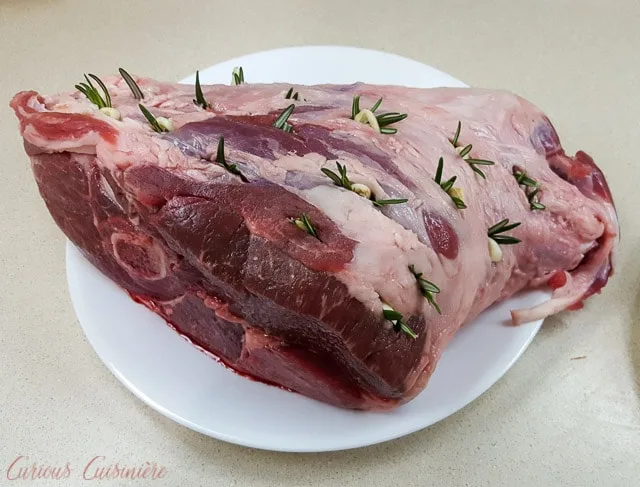
First, remember that you want to be cutting the meat across the grain into thin slices.
- Start with the leg of lamb on its side, working with the easiest side to access. Cut slices, perpendicular to the bone.
- These slices will remain attached to the leg, so after you slice the whole length of the bone, you will need to make a cut along the length of the bone, to separate the slices.
- Once you have a flat side, turn the meat onto that cut side (so it sets level) and begin slicing perpendicular to the bone through the other side.
- After slicing through the whole of the second side, again make a cut along the length of the bone to separate the slices.
There will be a lot of meat still left on the bone, but this gives you the best (and most easily accessible) slices to serve on a platter to your guests.
Don’t waste the meat that is still attached to the bone though!
Pick it off with your fingers (maybe after your guests leave) or save the bone with bits of meat for making stock or soup!
What should I serve with leg of lamb?
Traditionally le gigot d’agneau Pascal, or the French Easter leg of lamb is served with haricots verts (green beans) and gratin potatoes.
Our recipe for French roast leg of lamb with rosemary and garlic
As we mentioned before, this recipe is so incredibly simple.
All you need is your leg of lamb, some garlic cloves, fresh rosemary, salt and pepper, and a little olive oil.
You create slits in the raw meat to nestle the garlic and rosemary right into it, rather than on top. And, as the meat cooks, these robust flavorings really bring a lot of life and flavor into your leg of lamb.
It might seem like such an easy preparation wouldn’t yield an impressive result, but trust the French.
However, cooking it to the right temperature is key.
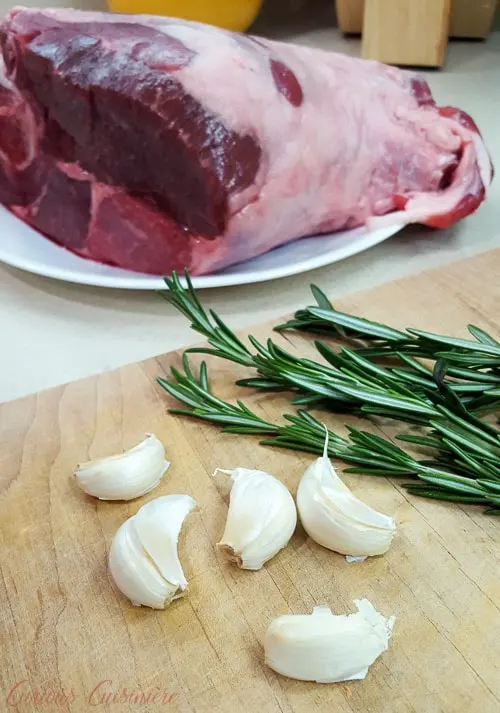
How to know when a leg of lamb is done
We HIGHLY recommend using an in-oven probe thermometer (affiliate link to our favorite thermometer) when cooking any kind of roast, but particularly bone-in roasts like this leg of lamb.
You want to cook the lamb so it is still pink. That way your meat will be tender. If you over-cook it, it can be tough.
Using an in-oven probe thermometer lets you set your target temperature and walk away, knowing that your alarm will sound when the meat hits that perfect spot.
If you don’t have an in-oven probe thermometer, we recommend taking your meat out of the oven to check the temperature starting 1 hour before it should be done, and then every 30 minutes after that. (More frequently if you’re really close to your target temperature.)
Make sure either thermometer is inserted into the center of the meatiest part of the leg.
At what temperature is a leg of lamb done?
That being said, what is your ‘target temperature’ to know when your leg of lamb is done?
According to the American Lamb Board, for medium rare you should remove your lamb from the oven at 135F and for medium you should remove it at 150F.
Your lamb will continue to cook as it rests, out of the oven, before you carve it. So for medium rare, your final temperature should be 145F and for medium, your final temperature should be 160F.
We really wouldn’t recommend cooking your leg any more than medium.
Keep in mind that parts of the leg are thicker than others, so even targeting somewhere between medium rare and medium (for example a pull temperature of 140F), will give you parts that are still nice and pink with other parts that are more well-done, for those who prefer their meat that way.
Cooked this way, the lamb is so flavorful and tender. You and your guests are sure to be amazed!
Le Gigot D’Agneau (French Roast Leg of Lamb)
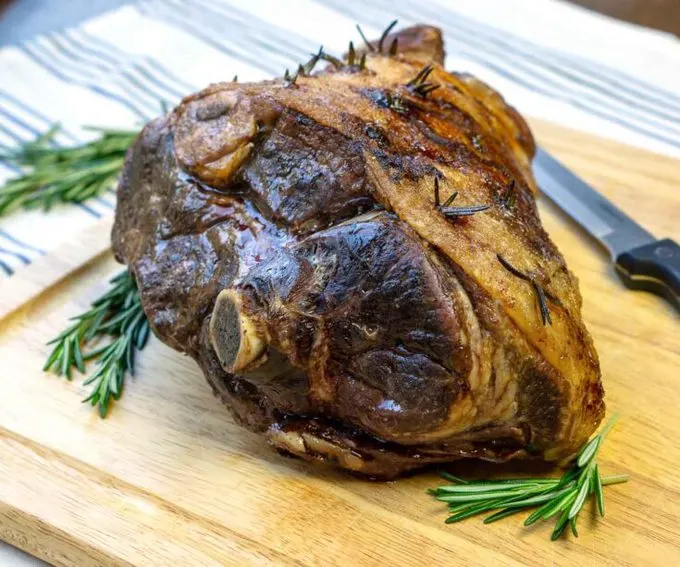
A leg of lamb is an impressive main dish for any celebration. This traditional French Easter dish of roast leg of lamb with rosemary and garlic is the perfect dish to wow any guests!
Note: For best flavor, season your lamb the night before you plan to roast it.
Ingredients
- 5-6 lb leg of lamb, bone in
- 5-7 garlic cloves, cut into slivers
- 2 large fresh rosemary sprigs
- Salt
- Pepper
- Olive oil
Instructions
The Night Before
- The night before you want to roast your lamb, cut 1 inch slits in the leg of lamb. Stuff the slits with garlic slices and rosemary sprigs. Place the lamb in a roasting pan with a roasting rack. Cover lightly with plastic wrap and refrigerate overnight to infuse with flavor.
Roasting The Lamb
- Remove the lamb from the refrigerator 2-3 hours before you want to start cooking to let it come to room temperature.
- Preheat your oven to 450F.
- Drizzle the lamb with olive oil and sprinkle with salt and pepper. If you have an in-oven probe thermometer, insert it into the center of the meatiest part of the leg.
- Roast the lamb at 450F for 15 minutes.
- Reduce your oven temperature to 300F. Open the oven door slightly to help drop the heat more quickly.
- Continue to roast the lamb at 300F for 20-25 minutes per pound for medium rare (or 25-30 minutes a pound for medium). (For a 5-6 lb leg of lamb, this means you will be roasting 1.5-2.5 hours for medium rare or 2-3 hours for medium.)
- Remove the lamb from the oven when it has reached 135F internal temperature for medium rare (or 150F for medium).
- Rest the lamb on the counter for 10-15 minutes, tented loosely with aluminum foil. As it rests, it will continue to cook. Your ending temperature for medium rare should be 145F (or 160F for medium).
- Carve the leg (as instructed in our article) and serve with green beans and gratin potatoes!
Notes
If desired, make a pan gravy with the juices and fat that are in the bottom of your roasting pan. Heat them in a saucepan with some extra beef broth or red wine to make 1 cup of liquids. Mix 1 Tbsp flour with 1 Tbsp water until smooth. Stir this slurry into the juices in the pan and simmer until thickened.
If you liked this recipe, here are some similar dishes you may enjoy!

Sarah is one of Curious Cuisiniere’s founding duo. Her love for cultural cuisines was instilled early by her French Canadian Grandmother. Her experience in the kitchen and in recipe development comes from years working in professional kitchens. She has traveled extensively and enjoys bringing the flavors of her travels back to create easy-to-make recipes.
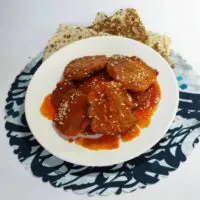
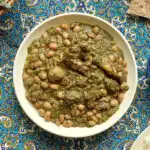
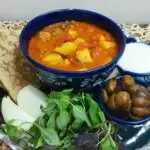

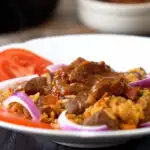
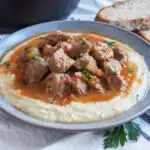
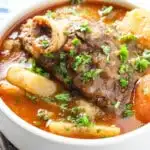

Georgia
Wednesday 3rd of June 2020
Excellent recipe! I used a thermometer and found that pulling the roast out at 140°F and resting for 10mins worked a little better for me than at 135°F, as 135 was a little more on the rare side, and quite bloody towards the bone despite cooking for the appropriate amount of time. Otherwise, absolutely wonderful! 10/10.
Sarah Ozimek
Thursday 4th of June 2020
Thank you for sharing Georgia. We're glad you enjoyed the recipe!